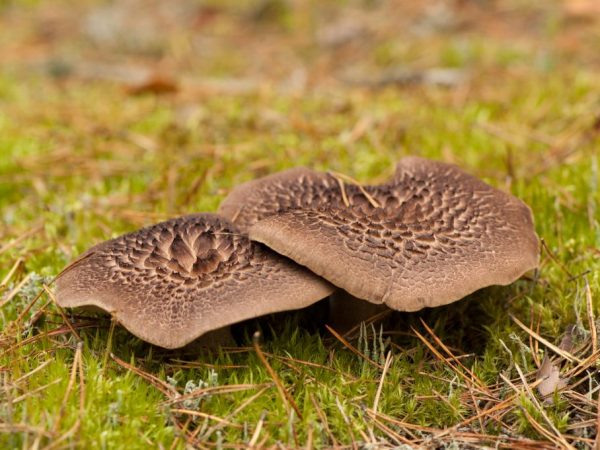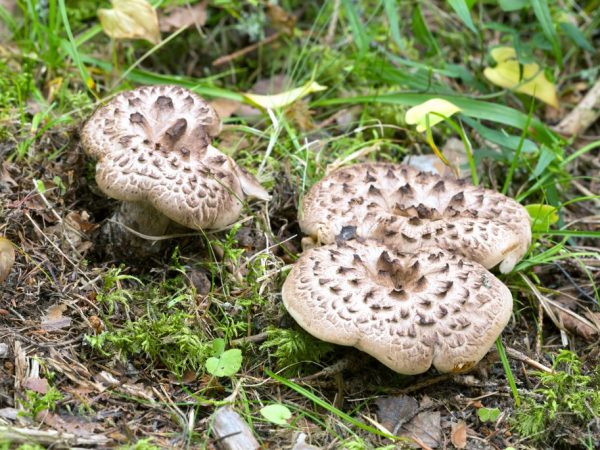Hedgehog mushroom
Outwardly, the hedgehog mushroom looks like a chanterelle, but it is also easy to confuse it with a toadstool. They don't like to collect the hedgehog mushroom: it has peculiar brittle thorns on the inside of the cap, they break off easily, as a result, all the mushrooms in the basket lose their attractive appearance. This is the reason why hedgehogs must be picked young.

Blackberry mushroom
The appearance of the mushroom
The black hat is cream colored. Its reverse side is strewn with "needles". The diameter of the cap is from 3 to 20 cm. It is hard, but fragile.
The hats of young specimens have a convex shape, they level out over time, and a depression forms in the center. Often the hat of a hedgehog is completely shapeless. The edges of the caps are tucked up. Juveniles have firm flesh with a firm structure and excellent aroma. The flesh of the old ones turns red. The skin is covered with bloom (edging).
The leg of the mushroom, according to the description, is thick (up to 2.5 cm), it can reach a height of 6 cm. Occasionally, the base of the hedgehogs is wider. The color of the leg is the same color as that of the cap, but in a lighter shade. Hericium has a spiny hymenophore, represented by special formations - frequent thorns.
Hericiums prefer to grow in different soils. The first specimens of this group grow in June, the last - in early autumn.

Brown shades of hedgehog hat
Views
Hericium has several types:
- Hericium yellow, or sinuate: edible species. Hat up to 12 cm in diameter. The pulp is yellow, firm, with a surface with tubercles. In a young individual, the cap is slightly convex, the edges are bent inward. It has a velvety texture, becomes denser with age, a dent forms in the center, waves appear at the edges. The color varies: sometimes yellow, but also turns to orange; if you press, it becomes darker, when dry - brightens. The mushroom has a light fruity aroma. The leg is up to 5 cm high, up to 4 cm thick, in the form of a cylinder, wide at the base. It grows in June and bears fruit until September. Mycorrhizal forming agent. It forms a fungus root with both coniferous and deciduous tree species, and is most often found in mixed forests where birch is present.
- Red-haired hericum, or reddish yellow: it is an edible mushroom with a red-colored cap, the edge of which is bent inward. Fragile needles are located on the inside of the cap. The leg is thick. The pulp is the same, beige, if you press, it becomes orange in color. Appears in September. Forms mycorrhiza with representatives of coniferous and deciduous tree species.
- Hericium is variegated: a hat with a diameter of 5-10 cm. It has a convex shape; over time, a depression forms in the central part; along the edge there is a "wave". Large scales completely cover the surface of the cap. The shade of the scales is brown. The young individual has a velvety texture, the old one is smooth. The pulp is white. The aroma is sharp, bitter. The leg is dry, dense, in the shape of a cylinder, wide at the bottom; height - 2-5 cm, thickness - 1-1.5 cm. Legs are gray. The spotted hedgehog grows in coniferous and mixed forests, singly and in groups. Appears from late summer to mid-autumn. Conditionally edible.Old individuals, due to the presence of bitterness in the taste, are not eaten. Capable of mycorrhiza formation. Chooses conifers as symbionts.
- Coral Hericium: according to the name, the shape of the mushroom is very similar to coral, the color of white coral. The flesh of a young individual is white, eventually turns yellow, with almost no aroma. Grows in deciduous forests on dead wood. Juveniles are edible. Coral hedgehog is listed in the Red Book.
- Curly Gericium, or barbel hedgehog: the color of the fruiting body of the fungus is white-pink, turns yellow with age. The hat of this type is covered with spines on the underside. The edge of the cap resembles a fringe. The flesh is dense, the same shade as the cap. Only young individuals are edible. The fungus grows in late summer and early autumn in deciduous and mixed forests, where it is a woody saprotroph.
- Hericium is gelatinous, or gelatinous pseudo-workman: the fruit body of the fungus is jelly-like (which underlines the name) in the form of a spoon, fan or tongue. The hat is up to 7.5 cm in diameter, dense, the edge is bent. The surface texture is smooth or velvety, white-gray in color, darkens over time. On the inside there are thorns. The leg is up to 5 cm high. The pulp is soft, there is almost no aroma and taste. The mushroom is conditionally edible, it is rarely eaten. It is an arboreal saprotroph.
- Hericum's rough: the cap of the mushroom is brown. Diameter - about 4-14 cm. The shape is depressed in the center. The surface is uneven, covered with scales of a darker shade. Also on the inner side there are thorns up to 1 cm high. The leg is 3-8 cm high, and 1-3.5 cm thick. The color of the leg is the same as that of the cap. The pulp is light. The smell of flour. The species grows in pine forests, from late summer to early autumn. Participates in the formation of mycorrhiza with coniferous and deciduous tree species.
Irina Selyutina (Biologist):
Not so long ago, when the shape of the fruiting bodies and the hymenophore was considered the leading features that determine the systematics of hymenomycetes, all species of fungi with a spiny or warty hymenophore were included in a single family - Ezhovikovs. Then it became clear that this feature - the structure of the hymenophore - is an excellent example of the phenomenon of convergence, which is observed in many aphyllophoric fungi of various origins. In-depth microscopic studies have shown that all mushrooms can be divided into different families. And today they include:
- this Hericiums - 2 species;
- this Banker - 4 types;
- this Hericiaceae - 3 species;
- this Hyaloricia - 1 species.
For your information. Species of barnacle mushrooms are classified as edible or conditionally edible mushrooms.

Hericium has several varieties.
Beneficial features
Hericium is an extraordinary mushroom that helps to cope with many problems:
- has antibacterial properties, provides protection against Escherichia coli, staphylococci, its juice can be used to treat a wound with a cut;
- allows you to quickly build muscle mass when used during intensive training;
- tones up, adds strength and energy;
- relieves depressive conditions;
- improves sleep;
- removes toxins;
- improves lung function, increases their volume;
- nourishes the body with useful substances - thanks to it, hair and nails become stronger and begin to grow faster;
- improves the quality of blood, accelerates its circulation.
Irina Selyutina (Biologist):
In 1998, scientists from Germany were able to isolate the compound erinacin E from the pulp of coral coral. Studies have shown it is able to stimulate the growth of neurons, which is extremely important for people suffering from Altsheimer's disease. In 2008, the same compound was synthesized in laboratory conditions by Japanese scientists. Now the development of a medical product based on it is underway. In addition, the antiparasitic activity of the coral barnacle has been proven.
Did you know? Chinese researchers believe that in terms of its medicinal data, the coral urchin is practically in no way inferior to the other medicinal species of the barnyard - the comb barbecue.
Contraindications
You should not eat blackberries in food for people suffering from pancreatitis, gastritis, liver problems, as well as mushroom intolerance in general.
If a person has a fever, it is also necessary to refuse to eat Black's Mane in food.
You should not eat mushrooms earlier than 3 months after surgery. They are contraindicated for children under 5 years old, pregnant and lactating women.
Application
Hericium has a lot of useful properties - it is not surprising that it is widely used in cooking and medicine.
In cooking
Most often, young specimens are used for cooking: their pulp is tender, with sourness. Adults use only after cooking, which makes them softer and removes the bitter taste. Before you start cooking, the cap is cleaned of thorns. After heat treatment, this type of mushroom hardly changes in size.

Hericium is widely used in cooking and medicine.
To prepare fried black man's flies, each mushroom is washed and peeled. A frying pan is greased with oil and heated. Then the mushrooms are cut into pieces and fried over low heat. When they are almost cooked, add finely chopped onions. Sour cream is introduced 5 minutes before readiness, then stewed.
For cooking in batter, mushrooms are cleaned and washed, then boiled in salted water. Young individuals will need 10-15 minutes, old ones - half an hour. For batter, 1 chicken egg is needed for every 10 pieces. Beat eggs and mix with flour. Spices are added. Fry until a crust appears. The dish is served hot with a sauce to taste.
In medicine
Hericiums contain components that have a positive effect on the human body. They are used to prepare an ointment used for the prevention of skin diseases. A cosmetic mask made from the pulp of the "hedgehog" nourishes with moisture and tones the skin.
The mushroom is widely used in traditional Chinese medicine. Tinctures and compresses are made from it, which help with diseases of the nervous system.
Conclusion
Species of black man's men are not popular among mushroom pickers, so they are almost never grown in summer cottages or greenhouses. When picking mushrooms, do not be afraid to take a "hedgehog" into the basket: after all, it will not only be a safe decoration for dishes, but will also be able to supplement the first-aid kit.



